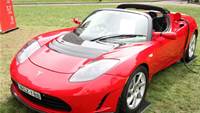Securing the grid
With all that information being collected and flowing around the networks, security and privacy will take on new meaning. The potential for abuse worries CSC senior security consultant Gabriel d'Eustachio - but not so much that he would call a halt to the rollouts.
"The amount of data you can deduce from someone's use patterns (from a meter) is really quite frightening," d'Eustachio says. "All of a sudden I know a lot about what you're doing during the day and when you're out of the house.
"I wonder if I could look at your power and your use pattern and deduce if there's an appliance that isn't working as well as it could so I'll market aggressively to you - as a private matter it's no one else's business.
"This data that can be mined [but] its data that is yours [the consumer's] - and we have to make sure we have regulatory bodies surrounding it so that people's privacy is respected."
He says the "public should weigh in on" laws and controls so that their energy and water use isn't weaponised to spy on them.
D'Eustachio sees opportunities for providers of security and privacy technologies and services to provide the ethical and legal foundations on which those with networking and marketing smarts, respectively, would collaborate.
CSC is working with technology companies as an honest broker to test the security claims of their products, he says.
Australia's smart grid work parallels that happening overseas. In announcing smart grid plans in January, US President Barack Obama identified that updating the archaic grid would save money, protect power sources from blackout or attack and "deliver clean, alternative forms of energy to every corner of our nation".
The US is throwing $US11 billion ($A13.75 billion) at smart grids as part of a $US50 billion plan to update its energy infrastructure. In June it released $US3.9 billion in grants; the Rudd Government committed $100 million in May to early work and Energy Australia will invest $10 million over five years for research at Sydney and Newcastle universities.
"In terms of the global horse race, we're up with the leaders, not up the front but close to the front," says energy consultant, Phil Perry, who has helped the Victorian Government write its smart meter policy since 2005.
"In the US there's a large number of [smart meter] programs being rolled out or planned. Over the next five years there will 100 million meters in the US replaced ... [and it] could rise significantly above that."
Texas and California are two hot states keen to see peak costs associated with air-conditioning constrained by smart networks and that's a main driver in Victoria and WA, Perry says, with the rising adoption of cooling in NSW and Queensland putting those states not far behind.
ZigBee's sting
Although much of the early work is aimed at managing distributors' grids, the inclusion of the ZigBee low-bandwidth wireless home-area networking technology should see smart appliances appear in homes and offices in a few years.
At present, data is collected from dumb meters only once every few months at most when a reader visits the house. Second-generation smart meters report back every half hour but the data may only be delivered daily and then only to the power companies. But the promise held out by smart meters is real-time delivery of data to consumers to help them modify their energy use behaviours, although energy insiders say this is a pipe dream in the next five to 10 years. If this day comes, ZigBee will be a key technology.
A house with a ZigBee wireless hub could be programmed to turn on the clothes dryer or dishwasher or defrost the fridge only at night when energy was cheap. And when electric cars such as the descendents of the Prius become as common as Commodores on our streets, stored power trickled into their batteries at night could be fed back into the grid to power the home or sold back to the power companies.
Such possibilities excite industry mavens who see an explosion of consumers becoming producers of energy through the installation of solar cells on their roofs, for instance, selling power into the grid to delay infrastructure spending.
And it raises the possibility of more technology in the house: imagine a dashboard on your wall or a software gadget on your computer or iPhone telling you how much energy courses through the network and identifying your use in real-time along with tips to save money. Even networking makers are looking to build such smarts into consumer routers and switches. And such ideas are trickling from US development labs at Google and Microsoft but the Australian infrastructure is yet to be primed to talk to such devices.
Such "critical" technology is being "actively debated" in national forums, Perry says.
"Government doesn't like prescribing technologies but, in this case, because we wanted to have the same consumer experience across all of Victoria, Government was driven to a point where we needed one standard, open interface," he says.
"This whole area of the ‘HAN' (home-area network) is huge and its benefits to society will be enormous - it will enable people to reduce peak demand on hot days without going to a lot of pain to do it [ie blackouts]. GE and Whirlpool in the US are working on fridges with ZigBee interfaces to defer the defrost cycle.
"The appliance makers will build in (intelligence) that says: ‘You want to run the dishwasher, OK, but it's peak time so it will cost you'. The same thing applies to air-conditioning: on peak periods it would by cycled - 15 minutes on, 15 minutes off. You wouldn't notice any appreciable change in comfort levels ... [or] you can say I want to override that [and pay the premium]."
Perry says the intent isn't for the power company to be a "Big Brother" but to give consumers control over their power use and spending and to reflect the real cost of generation while reducing carbon emissions.
And it's a "huge opportunity" for resellers, he says. "And electronics vendors ought to be getting busy and their products ready and their overall market positioning because HANs enable all range of stuff. There's so much that can be done in this space ... to optimise cost and comfort levels."
Click through to page three to see how to profit from smart grids and where to go for insider information.

.jpg&h=420&w=748&c=0&s=0)






_(22).jpg&h=140&w=231&c=1&s=0)
_(20).jpg&h=140&w=231&c=1&s=0)




_(26).jpg&w=100&c=1&s=0)

 iTnews Executive Retreat - Security Leaders Edition
iTnews Executive Retreat - Security Leaders Edition












_(1).jpg&h=140&w=231&c=1&s=0)



